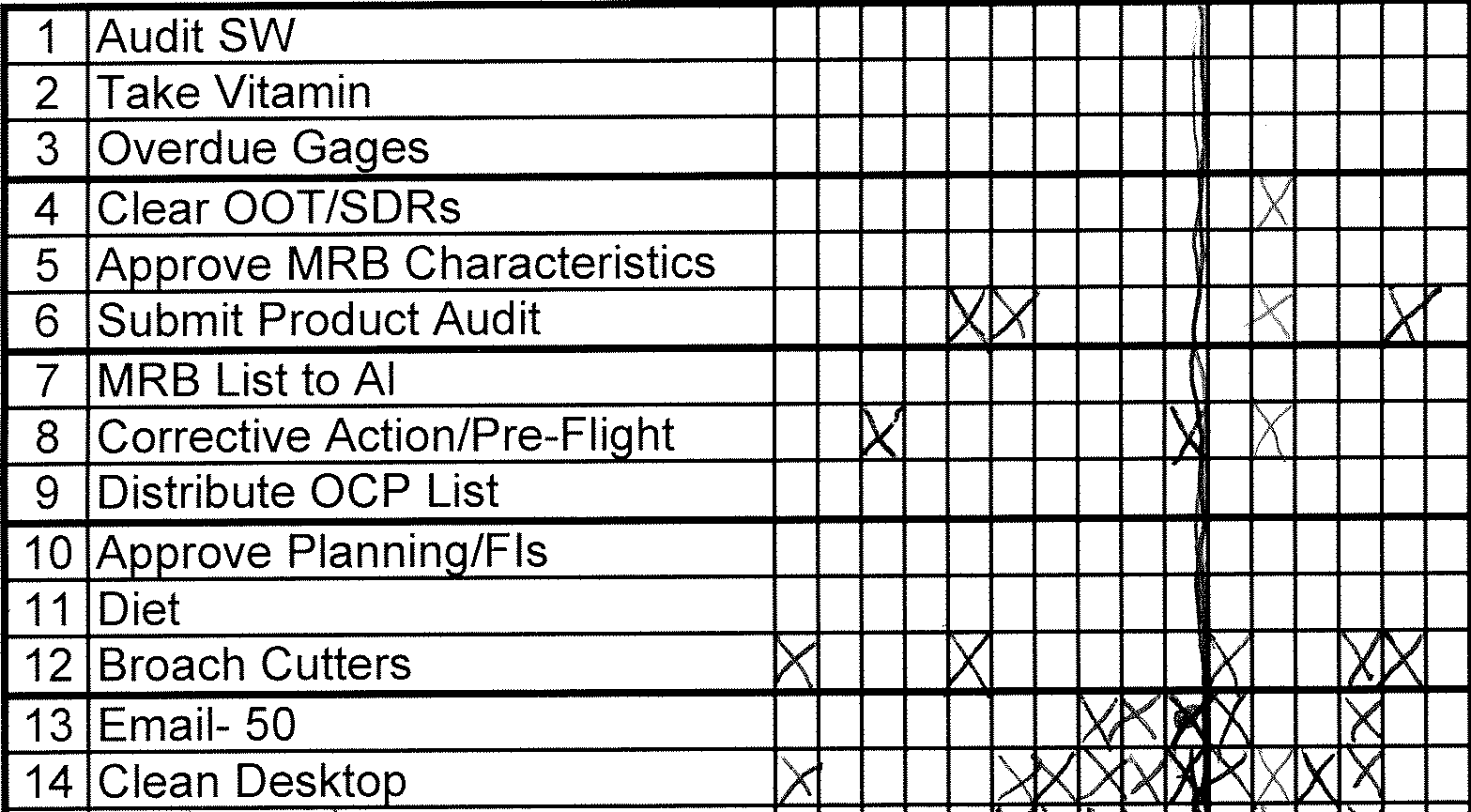Mark's Note: Here's part 3 of a series by our guest blogger, Andy Wagner – a series that started here.
Many of us work in an environment that our host, Mark Graban, would characterize as “non-Deming”: LAME more often than lean. After several months of long hours and work stress affecting home life, I made up my mind to do something about it. The answer, following a very evolutionary, unintentional path, became my Standard Work, and I have to tell you, I'm thrilled with progress to date, as described in posts one and two of this series.
I spent a weekend getting my personal email down to less than 5 messages, it's been there since late December. At work, my team and I are “green” on our Product Audits this quarter, and we've gone nearly thirty days without a gage out of calibration. We used to be the worst in both categories. As I developed my personal Standard Work, simple rules quickly emerged:
- Identify one delinquent, recurring task
- Identify the daily takt, the discrete unit of accomplishment needed to reduce the backlog
- Execute the task as top priority daily until the backlog is eliminated
- Maintain the daily rhythm
- Add the next delinquent task
I procured a simple checklist app for my iPod Touch. It automatically generates my daily checklists every weekday from a template that I edit when improvements come to me. The checklists grew, then stopped at a manageable point. I gradually powered through backlogs and anticipated getting into maintenance mode. Then came New Year's. There were a number of posts in the lean blogosphere about arbitrary New Year's Resolutions and Hoshin Kanri reflection for the year ahead. I was reading “Toyota Culture” at the time and I made up my mind very quickly that “use my checklist” was not an adequate resolution for the New Year.
The checklists were to be my Standard Work. By the end of December they had become that, but there was a piece missing. Standard Work must be audited. When you fail to meet the standard, you must find the root cause and perform a corrective action. That crucial step was missing from my Standard Work. Without that step, there would be no improvement. Realizing this over the year end break, I devised a simple method to audit my checklists. Each morning, I open my checklist tool and see what tasks went unfinished. I have a chart at my desk with each task listed. I put an “X” next to whatever I failed to do. At the end of the week, I have a little graph of where I fell short of the standard. After a couple weeks, I see the definite trends (click for a larger view):
One item fell short simply because I wasn't taking the time to execute on it. I powered through that the old fashioned way, just doing it, making the priority. The next item proved a bit more intractable. I was trying, but not making progress. There was simply too much variability in the discreteness of the task. Some days there was a “quick hit” I could make to complete the task, but other days, the tasks available were more time-consuming little projects. When I failed to finish the task, I ended up having to start from scratch the next day, redoing some of the work. I had to find a way to break the task down into something more manageable within my daily rhythm. This particular task has a simple if-then flow to it. You start with the simple questions to resolve it, and if they don't work, you investigate the more complex ones. In other words, it merits a checklist of its own. There was my answer: I turned the item in my Standard Work into its own mini-checklist. For the first item in the backlog, I quickly ran through all the simple items on the checklist. I wasn't finished, but I made a dent and I had a record of where to start the next day. Day two, I completed the task, no rework, within the time available in my day. Problem solved.
Level loading also made a guest appearance in my new Standard Work. I receive two types of process documents for my review and approval. One internal, one external. I made the more common internal review part of my checklist right away. I happily check it off routinely on days when I don't get any of these documents to review. Doing this, I soon found a backlog of the external documents, naturally, because the same person was creating the changes for the external document when he wasn't doing the internal ones! Why on earth hadn't I made that connection sooner? Quick change to the checklist, combining the two tasks as one checklist item. In three days, I was back to zero backlog again.
Combining similar items is obvious. More recently, I combined dissimilar items, similar only in the time and concentration that they take to complete. Neither comes to my desk every day. If both came on the same day, I'd be hard pressed to have the time to complete them. So, I made them one checklist item. If they come on the same day, my “takt” goal is to complete one of them, saving the other for the next day.
Having been at this for about five months, both at home and at work, it amazes me how much this process has changed my outlook and my attitude, as well as my metrics. My business unit went from the bottom to the top on a couple of key quality metrics based solely on this Standard Work. I, personally, went from beleaguered and hopeless to energized and excited about the months ahead, eager to watch my new process unfold around me. I see the magic of Standard Work, the audits, the PDCA-cycle, and the constant tightening of the screws to get more performance out of myself and my team. I'm learning about lean by applying it in a place not always friendly to the ideas, every single day.
Part 4 will appear next week…
What do you think? Please scroll down (or click) to post a comment. Or please share the post with your thoughts on LinkedIn – and follow me or connect with me there.
Did you like this post? Make sure you don't miss a post or podcast — Subscribe to get notified about posts via email daily or weekly.
Check out my latest book, The Mistakes That Make Us: Cultivating a Culture of Learning and Innovation:











Andy –
I have really enjoyed your posts about your standardized work. It is great how you have used it. Leader Standardized Work is big where I work but they still don’t see it as a common check list. The leaders see it as their calendar and note taking page. How can I get them to see it as a simple checklist and use it to problem solve you you have? So far, the normal coaching routine isn’t working.
Also, what is the name of the app you used? Good use of technology to support your process.
I just wanted to add that I really appreciate Andy sharing his very personal lean journey with us all.
Matt,
I, from time to time have had the same problem–treating the checklist like a schedule. My routine is to start my checklist first thing in my day, and it’s sequenced in the rhythm of a typical day, but there’s no day that’s “typical.” I have to resist the temptation to be a slave to the checklist. I have to break off, handle the urgent issues of the day, as always, and try to come back later to finish up.
I found the key is the “audit” process that I described. You should fail to meet the standard on a regular basis, and work conscientiously on your corrective actions.
The app that I use is called “Checklist Wrangler,” but there are others out there. I didn’t spend a lot of time picking one. Paper works too!
–Andy
Sounds like you’ve come up with a system similar to David Allen’s “Getting Things Done”. He treats projects the same way as you, by breaking them into smaller checklists. I like how you use the audit system to track your improvements. Nice!
Thanks, Leansim.
I’ve read a bit about GTD, but should probably study it more.
My focus has been on short-term repetitive tasks, to open up my day for major projects.
I think the audit system is actually the real key to improvement in the way I’ve been using the checklist. I was inspired in the basic concept by Jeff Liker’s Toyota Culture and his writing there on Standard Work.
-Andy